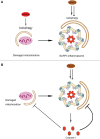The Role of HDAC6 in Autophagy and NLRP3 Inflammasome
- PMID: 34777380
- PMCID: PMC8578992
- DOI: 10.3389/fimmu.2021.763831
The Role of HDAC6 in Autophagy and NLRP3 Inflammasome
Abstract
Autophagy fights against harmful stimuli and degrades cytosolic macromolecules, organelles, and intracellular pathogens. Autophagy dysfunction is associated with many diseases, including infectious and inflammatory diseases. Recent studies have identified the critical role of the NACHT, LRR, and PYD domain-containing protein 3 (NLRP3) inflammasomes activation in the innate immune system, which mediates the secretion of proinflammatory cytokines IL-1β/IL-18 and cleaves Gasdermin D to induce pyroptosis in response to pathogenic and sterile stimuli. Accumulating evidence has highlighted the crosstalk between autophagy and NLRP3 inflammasome in multifaceted ways to influence host defense and inflammation. However, the underlying mechanisms require further clarification. Histone deacetylase 6 (HDAC6) is a class IIb deacetylase among the 18 mammalian HDACs, which mainly localizes in the cytoplasm. It is involved in two functional deacetylase domains and a ubiquitin-binding zinc finger domain (ZnF-BUZ). Due to its unique structure, HDAC6 regulates various physiological processes, including autophagy and NLRP3 inflammasome, and may play a role in the crosstalk between them. In this review, we provide insight into the mechanisms by which HDAC6 regulates autophagy and NLRP3 inflammasome and we explored the possibility and challenges of HDAC6 in the crosstalk between autophagy and NLRP3 inflammasome. Finally, we discuss HDAC6 inhibitors as a potential therapeutic approach targeting either autophagy or NLRP3 inflammasome as an anti-inflammatory strategy, although further clarification is required regarding their crosstalk.
Keywords: HDAC6; NLRP3 inflammasome; autophagy; inflammation; post-translational modification.
Copyright © 2021 Chang, Li, Hu, Li and Wang.
Conflict of interest statement
The authors declare that the research was conducted in the absence of any commercial or financial relationships that could be construed as a potential conflict of interest.
Figures



Similar articles
-
Histone deacetylase 6 negatively regulates NLRP3 inflammasome activation.Biochem Biophys Res Commun. 2015 Nov 27;467(4):973-8. doi: 10.1016/j.bbrc.2015.10.033. Epub 2015 Oct 21. Biochem Biophys Res Commun. 2015. PMID: 26471297
-
Knockdown of HDAC6 alleviates ventricular remodeling in experimental dilated cardiomyopathy via inhibition of NLRP3 inflammasome activation and promotion of cardiomyocyte autophagy.Cell Biol Toxicol. 2023 Oct;39(5):2365-2379. doi: 10.1007/s10565-022-09727-z. Epub 2022 Jun 28. Cell Biol Toxicol. 2023. PMID: 35764897
-
Pharmacological inhibition of HDAC6 suppresses NLRP3 inflammasome-mediated IL-1β release.Biochem Pharmacol. 2023 Sep;215:115693. doi: 10.1016/j.bcp.2023.115693. Epub 2023 Jul 20. Biochem Pharmacol. 2023. PMID: 37481141
-
Interplay Between NLRP3 Inflammasome and Autophagy.Front Immunol. 2020 Oct 9;11:591803. doi: 10.3389/fimmu.2020.591803. eCollection 2020. Front Immunol. 2020. PMID: 33163006 Free PMC article. Review.
-
The interaction between autophagy and neuroinflammation in major depressive disorder: From pathophysiology to therapeutic implications.Pharmacol Res. 2021 Jun;168:105586. doi: 10.1016/j.phrs.2021.105586. Epub 2021 Mar 31. Pharmacol Res. 2021. PMID: 33812005 Review.
Cited by
-
The Role of Genetic Mutations in Mitochondrial-Driven Cancer Growth in Selected Tumors: Breast and Gynecological Malignancies.Life (Basel). 2023 Apr 12;13(4):996. doi: 10.3390/life13040996. Life (Basel). 2023. PMID: 37109525 Free PMC article. Review.
-
VHL ameliorates arecoline-induced oral submucosal fibrosis by promoting HDAC6 ubiquitination and blocking NF-κB pathway.Sci Rep. 2025 Mar 4;15(1):7563. doi: 10.1038/s41598-025-91207-5. Sci Rep. 2025. PMID: 40038412 Free PMC article.
-
Histone Deacetylase (HDAC) Inhibitors as a Novel Therapeutic Option Against Fibrotic and Inflammatory Diseases.Biomolecules. 2024 Dec 15;14(12):1605. doi: 10.3390/biom14121605. Biomolecules. 2024. PMID: 39766311 Free PMC article. Review.
-
Pentadecanoic acid attenuates thioacetamide-induced liver fibrosis by modulating oxidative stress, inflammation, and ferroptosis pathways in rat.Naunyn Schmiedebergs Arch Pharmacol. 2025 May 1. doi: 10.1007/s00210-025-04143-6. Online ahead of print. Naunyn Schmiedebergs Arch Pharmacol. 2025. PMID: 40310526
-
Targeting HDAC6 to Overcome Autophagy-Promoted Anti-Cancer Drug Resistance.Int J Mol Sci. 2022 Aug 24;23(17):9592. doi: 10.3390/ijms23179592. Int J Mol Sci. 2022. PMID: 36076996 Free PMC article. Review.
References
Publication types
MeSH terms
Substances
LinkOut - more resources
Full Text Sources
Other Literature Sources

